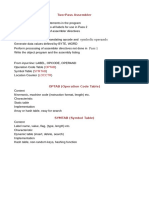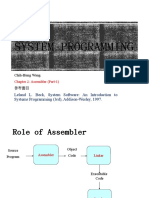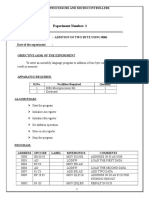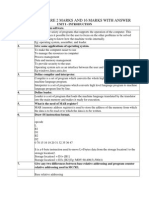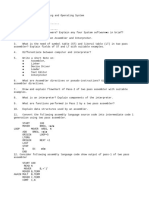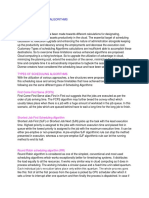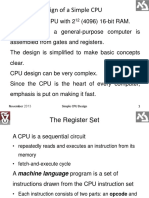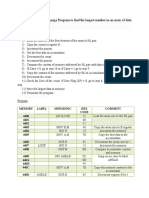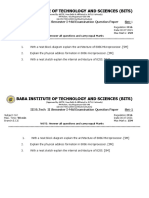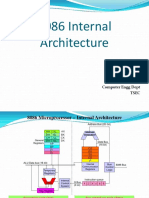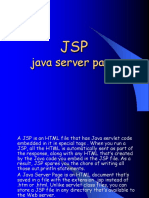2 Pass Assembler Algorithm
Uploaded by
Saraswati Bhusanur2 Pass Assembler Algorithm
Uploaded by
Saraswati BhusanurTwo Pass Assembler Algorithm
Data Structures
1. Operation Code Table (OPTAB)
Used to look up mnemonic operation codes and translate them into machine language equivalents Contains the mnemonic operation code and its
machine language equivalent In more complex assemblers, contains information like instruction format and length.
2. Symbol Table
Used to store values (addresses) assigned to labels Includes the name and value for each label Flags to indicate error conditions, e.g. duplicate definition
of labels
May contain other info like type or length about the data area or instruction labeled
3. LOCCTR
Used to help in the assignment of addresses Initialized to the beginning address specified in the START statement After each source statement is
processed, the length of the assembled instruction or data area to be generated is added. Gives the address of a label
In Two pass algorithm:
Pass 1 (Define symbols):
(a)Assign addresses to all statements (LOC)
(b) Save the addresses assigned to all labels in symbol table
(c) Perform some processing for assembler directives
Pass 2 (Generate object code):
a. Translate opcode and operands
b. Generate data values for WORD
c. Write object program
Pass 1: Pass 2:
begin begin
read first input line read first input file {from intermediate file}
if OPCODE = 'START' then if OPCODE = 'START' then
begin begin
save #[OPERAND] as starting address write listing line
initialized LOCCTR to starting address read next input line
write line to intermediate file end {if START}
read next input line write header record to object program
end {if START} initialized first Text record
else while OPCODE != 'END' do
initialized LOCCTR to 0 begin
while OPCODE != 'END' do if this is not a comment line then
begin begin
if this is not a comment line then search OPTAB for OPCODE
begin if found then
if there is a symbol in the LABEL field then begin
begin if there is a symbol in OPERAND field then
search SYMTAB for LABEL begin
if found then search SYMTAB for OPERAND
set error flag (duplicate symbol) if found then
else store symbol value as operand address
insert (LABEL, LOCCTR) into SYMTAB else
end {if symbol} begin
search OPTAB for OPCODE store 0 as operand address
if found then set error flag (undefined symbol)
add 3 {instruction lengh} to LOCCTR end
else if OPCODE = 'WORD' then end {if symbol}
add 3 to LOCCTR else
else if OPCODE = 'RESW' then store 0 as operand address
add 3 * #[OPERAND] to LOCCTR assemble the object code instruction
else if OPCODE = 'RESB' then end {if opcode found}
add #[OPERAND] to LOCCTR else if OPCODE = 'BYTE' or 'WORD' then
else if OPCODE = 'BYTE' then convert constant to object code
begin if object code not fit into the current Text record then
find length of constant in bytes begin
add length to LOCCTR write Text record to object program
end {if BYTE} initialized new Text record
else end
set error flag (invalid operation code) add object code to Text record
end {if not a comment} end {if not comment}
write line to intermediate file write listing line
read next input line read next input line
end {while not END} end {while not END}
write last line to intermediate file write last Text record to object program
save (LOCCTR - starting address) as program length write End record to object program
write last listing line
end
You might also like
- Ms-Dos Linker: Dhriti Das (Roll No-07) Simsima Gogoi (Roll No-17) Tanmi Bharadwaj (Roll No-18)0% (1)Ms-Dos Linker: Dhriti Das (Roll No-07) Simsima Gogoi (Roll No-17) Tanmi Bharadwaj (Roll No-18)28 pages
- System Software 2 Marks and 16 Marks With AnswerNo ratings yetSystem Software 2 Marks and 16 Marks With Answer23 pages
- Chapter-5: Assembly Language Programming Using 8086 (16 Marks)100% (2)Chapter-5: Assembly Language Programming Using 8086 (16 Marks)55 pages
- Advanced Computer Architecture Question PaperNo ratings yetAdvanced Computer Architecture Question Paper1 page
- Instruction Codes Computer Registers Computer Instructions Timing and Control Instruction Cycle Memory Reference Instructions Input-Output and Interrupt Complete Computer DescriptionNo ratings yetInstruction Codes Computer Registers Computer Instructions Timing and Control Instruction Cycle Memory Reference Instructions Input-Output and Interrupt Complete Computer Description38 pages
- 8086 Program To Convert An 8 Bit BCD Number Into Hexadecimal Number100% (1)8086 Program To Convert An 8 Bit BCD Number Into Hexadecimal Number4 pages
- CSC3201 - Compiler Construction (Part II) - Lecture 5 - Code GenerationNo ratings yetCSC3201 - Compiler Construction (Part II) - Lecture 5 - Code Generation64 pages
- Features of Pentium and Above Microprocessors0% (1)Features of Pentium and Above Microprocessors5 pages
- Data Segment Data Ends Code Segment Assume Ds:Data, Cs:Code: 1) 8086/masm Program On Fibonacci Series75% (4)Data Segment Data Ends Code Segment Assume Ds:Data, Cs:Code: 1) 8086/masm Program On Fibonacci Series15 pages
- Write A Program To Multiply Two 16 Bit Binary NumbersNo ratings yetWrite A Program To Multiply Two 16 Bit Binary Numbers10 pages
- Final Microprocessor Lab Manual 2019 PatternNo ratings yetFinal Microprocessor Lab Manual 2019 Pattern43 pages
- Hardware Interfaces To 8051: 1. LCD 2. Keyboard 3. ADC 4. DAC 5. Stepper Motor 6. DC MotorNo ratings yetHardware Interfaces To 8051: 1. LCD 2. Keyboard 3. ADC 4. DAC 5. Stepper Motor 6. DC Motor32 pages
- Pushdown Automata (PDA) : Unit Iii-Push Down AutomataNo ratings yetPushdown Automata (PDA) : Unit Iii-Push Down Automata27 pages
- Implementation of Masm (Microsoft Macro Assembler) AssemblerNo ratings yetImplementation of Masm (Microsoft Macro Assembler) Assembler2 pages
- Microprocessor Experiment No.: 1 Use of Programming Tools Microprocessor Lab Experiment No.: 1 Use of Programming ToolsNo ratings yetMicroprocessor Experiment No.: 1 Use of Programming Tools Microprocessor Lab Experiment No.: 1 Use of Programming Tools8 pages
- Unit 2 Assemblers: 2.1 Machine Independent Assembler Features100% (1)Unit 2 Assemblers: 2.1 Machine Independent Assembler Features26 pages
- 2019 Summer Model Answer Paper (Msbte Study Resources)No ratings yet2019 Summer Model Answer Paper (Msbte Study Resources)28 pages
- COE 205 Lab Manual Experiment N o 1 1 inNo ratings yetCOE 205 Lab Manual Experiment N o 1 1 in10 pages
- Void Pointer in C: Declaration of The Void Pointer Is Given BelowNo ratings yetVoid Pointer in C: Declaration of The Void Pointer Is Given Below6 pages
- Authorised Service Provider Locator - ToshibaNo ratings yetAuthorised Service Provider Locator - Toshiba2 pages
- Syllabus MSC IT 2015 Batch Onwards PTU DDENo ratings yetSyllabus MSC IT 2015 Batch Onwards PTU DDE41 pages
- An Interview With 'Henry Deacon' - Updates - February-December 2007#an Important New Statement From Henry Deacon#an Important New Statement From Henry Deacon#an Important New Statement From Henry DeaconNo ratings yetAn Interview With 'Henry Deacon' - Updates - February-December 2007#an Important New Statement From Henry Deacon#an Important New Statement From Henry Deacon#an Important New Statement From Henry Deacon18 pages
- E-Con: Faculty Attitudes Toward Electronic ResourcesNo ratings yetE-Con: Faculty Attitudes Toward Electronic Resources2 pages
- Mixed Media 3 Step-by-Step Lessons For Experimental Painting PDF100% (1)Mixed Media 3 Step-by-Step Lessons For Experimental Painting PDF18 pages
- Heydar Aliyev Cultural Centre: StructureNo ratings yetHeydar Aliyev Cultural Centre: Structure3 pages
- Consumer Behavior Research: Jesilyn T. Sabay, MMTNo ratings yetConsumer Behavior Research: Jesilyn T. Sabay, MMT56 pages
- Bonita Documentation - Sap Jco3 - 2014-04-22No ratings yetBonita Documentation - Sap Jco3 - 2014-04-223 pages
- The Music Tree Activities Book Part 1 Music Tree Summy PDF Book by Frances Clark0% (3)The Music Tree Activities Book Part 1 Music Tree Summy PDF Book by Frances Clark3 pages



